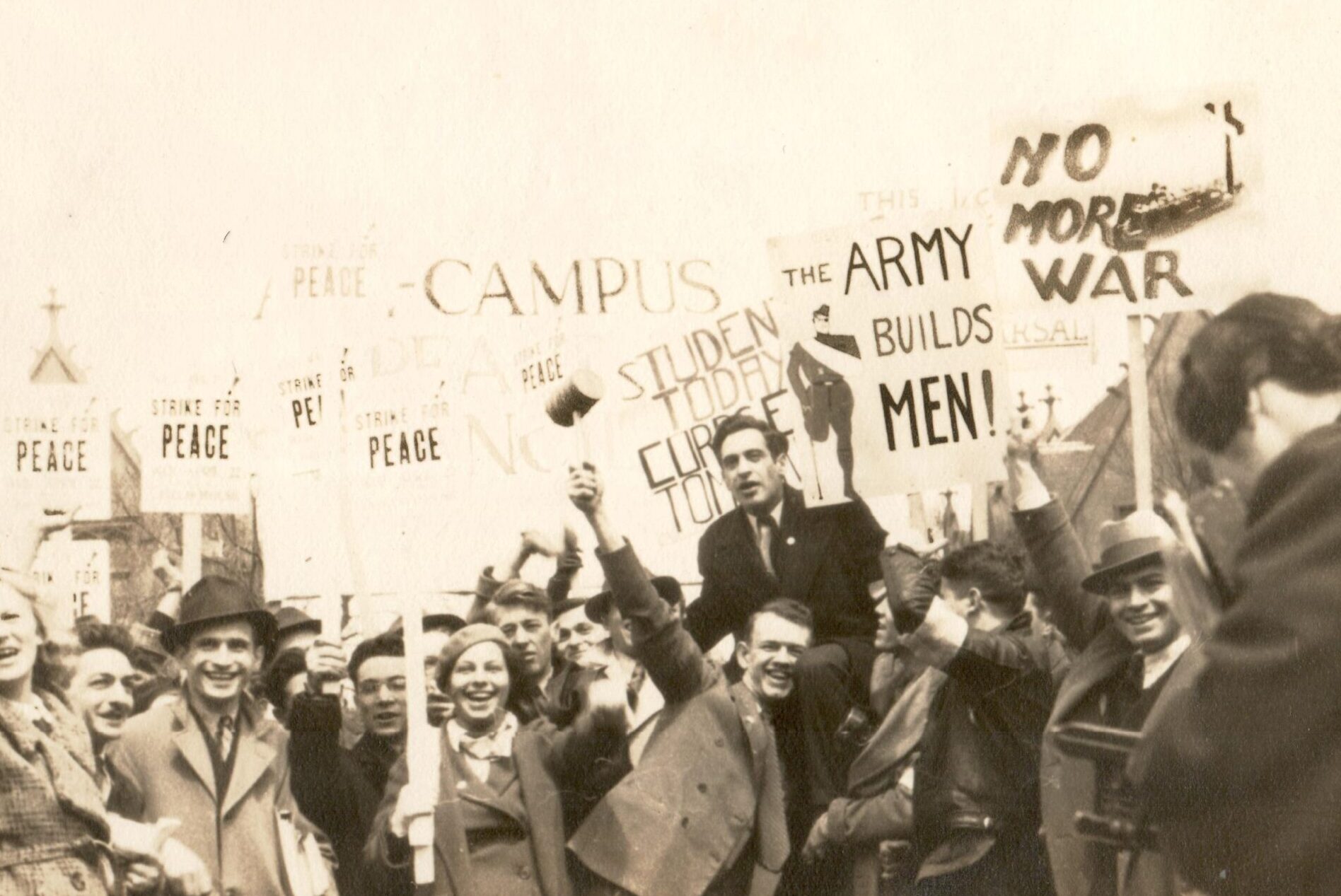We’re in a celebratory mood at The American Spectator. Dan Flynn, TAS senior editor, star columnist, and purveyor of the beloved Spectator A.M. newsletter, has just released his seventh book, The Man Who Invented Conservatism: The Unlikely Life of Frank S. Meyer. It sounds like a doozy.
Clearly, fusionism does not influence as many conservatives as it once did. My sense is that the right inevitably comes back to it.
The book focuses on one of the most enigmatic and under-celebrated figures in American intellectual life, Frank Meyer. Educated at Princeton, Oxford, and the London School of Economics, Meyer was a founding editor of National Review at its inception in 1955 and became a close confidant of William F. Buckley, who credited Meyer with successfully merging the two major strains of conservative thought, traditionalism and libertarianism. Meyer’s synthesis, known as “fusionism,” became the intellectual backbone of American conservatism and Republican platforms.
Flynn’s take on Meyer’s journey from a Communist Party USA apparatchik in the ‘30s and ‘40s to the hallowed halls of National Review and intellectual stardom, promises to be captivating, not only because of Meyer’s philosophical ululations, but also because Meyer was a cause célèbre who captured the support of Bertrand Russell and Clement Attlee, an editor who first published the freelance work of Joan Didion, and attracted several famous and sought after women. “Frank led a technicolor, 3-D life,” Flynn told TAS, as he settled in for a question-and-answer session about the book with the editors.
TAS: Most of us at TAS are familiar with the work of the major figures of conservative thought in the 20th century. On a fairly regular basis we field articles on figures such as Hayek, Buckley, Burnham, Friedman, and Kirk. But it is rare that Frank Meyer comes up in our discussions or in our submissions stack. Why do you think that is, and what attracted you to the subject?
Flynn: Frank Meyer was hiding. My mission was to find him. The Man Who Invented Conservatism begins with discussions by British Communists, caught by intelligence wiretaps, on erasing Frank Meyer from their history. Headlines reaching London had just announced Meyer as a “mystery witness” in what became the longest, most expensive court case in U.S. history. The Smith Act Trial sent 11 of Meyer’s former comrades, to include then party leader Eugene Dennis and future party leader Gus Hall, to prison. Communists responded by deleting Meyer from their history. Conservatives erased him by neglect. Whereas James Burnham’s papers reside at the Hoover Institution, William F. Buckley’s at Yale, and William Rusher’s at the Library of Congress, Meyer’s papers were collecting dust and insects in an unlikely hiding place.

Frank Meyer (center above the crowd) worked as a ‘peace’ organizer for Walter Ulbricht, the Stalinist who later built the Berlin Wall. Meyer was also a delegate to the World Congress Against War in Amsterdam in August 1932.
TAS: The philosophical journey from the Left to the Right is a story that conservatives are familiar with, especially as told by “neoconservatives” such as Irving Kristol and Norman Podhoretz who were repulsed by Stalinism. But Meyer’s route from communism to conservatism seems different from theirs. Is this the case? What was the catalyst for Meyer’s conversion?
Flynn: There were about six catalysts. May I focus on a few? Once Operation Barbarossa tore up the Hitler-Stalin Pact, American Communists exhorted Americans to fight the Nazis. Meyer sought permission from his bosses to do just that. They refused. What they said publicly conflicting with what they did privately jarred Meyer. When they relented, Meyer at last met the working class. The squad-bay population was not the proletariat that Marx had described. When Moscow deposed Earl Browder as party head in America, Meyer, who had urged him to Americanize the party, essentially followed him out the door. It’s more complicated than that, and Friedrich Hayek plays a supporting role. But all that finds a fuller explanation in a book rather than a paragraph.
TAS: Meyer’s “fusionism” was an attempt to marry the traditionalist and libertarian strains of conservatism in the U.S. Did he successfully carry this out? How did it manifest itself in American politics?
Flynn: From Barry Goldwater well through Ronald Reagan, fusionism acted as the default philosophy of the American Right. It told traditionalists and libertarians that their beliefs worked in cooperation and not conflict. The simplicity of the idea, its truth, and its political utility all contributed to its popularity.

TAS: There are some indications that the Republican Party is now rent by tension between social conservatives and libertarians. Does that mean Meyer’s fusionism is on the way out?
Flynn: Clearly, fusionism does not influence as many conservatives as it once did. My sense is that the right inevitably comes back to it. If you are an American conservative, what do you propose to conserve? The obvious answer that fusionism offers is the American Founding. The Founding is our tradition and its significance involves freedom. That’s where the fusion of these seemingly disparate outlooks of traditionalism and libertarianism comes into play.
TAS: What do you think Meyer would say about the rise of Trump and MAGA-style populism? Was there anything about Meyer’s theories that might have, at least in some ways, led to the rise of Trumpism?
Flynn: Meyer cringed at the “populist” label. Still, he full-throatedly defended Joe McCarthy and popularized the notion of “the Establishment” in the late 1950s. Though he yielded to no one in his anti-Communism, Meyer noted that, absent the existential threat posed by the Soviet Union, the United States would rightly abstain from the United Nations, foreign aid, and foreign interventions of the likes of Vietnam because the social systems of other countries do not concern us.
TAS: Meyer was born to a Jewish family but converted to Catholicism before his death. Considering that religious faith is a primary component of contemporary conservatism, could you tell us about the place of religion in Meyer’s life and philosophy?
Flynn: I found Meyer’s first published article, a 14-year-old’s spirited defense of Reform Judaism on the occasion of the Feast of the Tabernacles, in a Jewish archive in New Jersey. Two years later, Meyer won an award at Newark Academy for an essay in which he defends atheists and Bolsheviks. Like so many teenagers, he changed dramatically from 14 to 16. He told Mike Wallace in 1961 that if he had been born into a more demanding faith—say, Orthodox Judaism—he might have stayed. His years at Oxford presented him two demanding faiths: Communism and Catholicism. He chose Communism for 14 years. He chose Catholicism for the last six hours of his life. The path leading to the church started more than 40 years earlier at Oxford.
TAS: You’ve said that Meyer lived a “technicolor 3D life” in and around celebrity notables and the glitterati. I think you said that he even dated the British Prime Minister’s daughter at some point. Can you give us a juicy tidbit or two from the book?
Flynn: British Communists credited Meyer with founding the party’s student movement in the United Kingdom. At the same time that Meyer was calling for the violent overthrow of Prime Minister Ramsay MacDonald’s government, he was secretly dating MacDonald’s youngest daughter. One letter I found from her in the warehouse invites him to meet her at 10 Downing Street on a night in which her father was gone. Did Che Guevara or John Reed ever pull off a caper as daring as that? Frank Meyer was brash.
TAS: Meyer’s colleague at NR, James Burnham, has had quite a revival in recent years, as many believe he foretold of the increasing power of a “managerial class” and unaccountable bureaucracy. But Meyer and Burnham did not care for each other. Was their disagreement personal or philosophical?
Flynn: Their disagreement was all of that and more. One learns with great specificity the contempt, through discovered letters and suppressed memos included in the book, that Meyer and his faction held for Burnham. Two ex-leftists, Burnham was a Trotskyist and Meyer a Stalinist. Both men’s times at Princeton and Balliol College, Oxford, overlapped. If someone did not say it, I will here: James Burnham’s conservatism started at the water’s edge; Meyer and company sought not merely to defeat Communism abroad but revoke the New Deal at home. Meyer was gregarious and excitable; Burnham, cool and aloof. Their personalities clashed. Their politics clashed. Their histories clashed. They waged a battle for the soul of National Review. Meyer lost. But in the broader battle for the soul of the emerging conservative movement, Meyer triumphed over Burnham.
TAS: Meyer seems to have had the wind at his back when he testified against Communists in the 1950s. But he was going against the grain in the 1960s, when he held fast, even in the face of the Civil Rights Revolution, to his belief in states’ rights and federalism. Did Meyer oppose the federal government’s effort to desegregate the South? Did he oppose the Civil Rights Act of 1964?
Flynn: Meyer’s proposed dissertation at the University of Chicago centered on African Americans, he celebrated the integration of his Army platoon while training to become an officer, and he regarded George Wallace about as dimly as any major American political figure of his lifetime. He nevertheless took a jaundiced view of the civil rights movement of the 1960s primarily because a) he viewed civil disobedience in a republic with redress of grievance as immoral and a form of blackmail, i.e., do as we demand or else; b) it empowered the state to interfere in all sorts of heretofore private matters, to include who an employer hires and who a homeowner rents to; and c) it rested on the reflexive assumption that disparate outcomes for different groups necessarily stemmed from disparate treatment (external factors).
TAS: The research you did for this book seems remarkable. You rely on previously unknown personal letters to and from Meyers, some of which, strangely, were unearthed in an old Pepsi warehouse in Altoona, Pennsylvania. How did you come to this trove of information and what other sources did you rely on?
FLYNN: When I was four, I wished myself invisible in certain uncomfortable situations. In my forties, I again conjured that superpower — albeit not to hide myself but to reveal what I saw when I closed my eyes. I wished the Frank Meyer archive into existence out of desperation. Covid closed archives, the federal government responded to my FOIA request by essentially telling me to check back in a decade, and what purported to be Meyer’s papers at the Hoover Institution struck as incomplete in such a way as to suggest missing parts. When I was four, I closed my eyes to become invisible. In my forties, I again closed my eyes. I fell asleep and dreamt of finding Frank Meyer’s papers. After two years, my wish came true. I opened my eyes in a beat-up warehouse in Altoona, Pennsylvania, to drown in letters from everyone from J. Edgar Hoover to Evelyn Waugh to Henry Kissinger to Joan Didion to Barry Goldwater. They were addressed to Frank Meyer. I knew that they were really meant for me.
READ MORE from Daniel J. Flynn on conservatism:
A Lefty Reviews The Man Who Invented Conservatism
Finding the Lost Papers of the Conservative Movement
David Horowitz Leaves Us Just As We Need Him Now More Than Ever





![Gavin Newsom Threatens to 'Punch These Sons of B*thces in the Mouth' [WATCH]](https://www.right2024.com/wp-content/uploads/2025/08/Gavin-Newsom-Threatens-to-Punch-These-Sons-of-Bthces-in-350x250.jpg)
![ICE Arrests Illegal Alien Influencer During Her Livestream in Los Angeles: ‘You Bet We Did’ [WATCH]](https://www.right2024.com/wp-content/uploads/2025/08/ICE-Arrests-Illegal-Alien-Influencer-During-Her-Livestream-in-Los-350x250.jpg)
![Black BET Billionaire Donor Stuns Democrats, Gives $500K to Winsome Earle-Sears [WATCH]](https://www.right2024.com/wp-content/uploads/2025/08/Black-BET-Billionaire-Donor-Stuns-Democrats-Gives-500K-to-Winsome-350x250.jpg)






